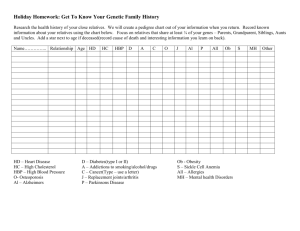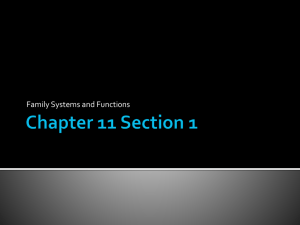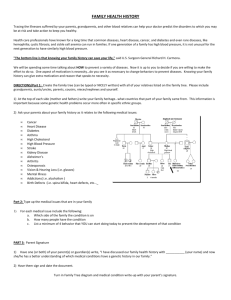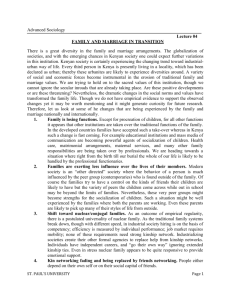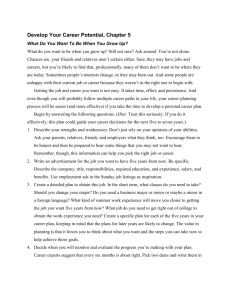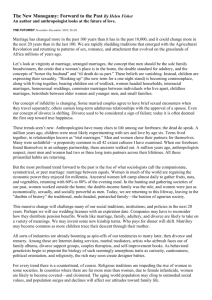Chapter Twelve
advertisement
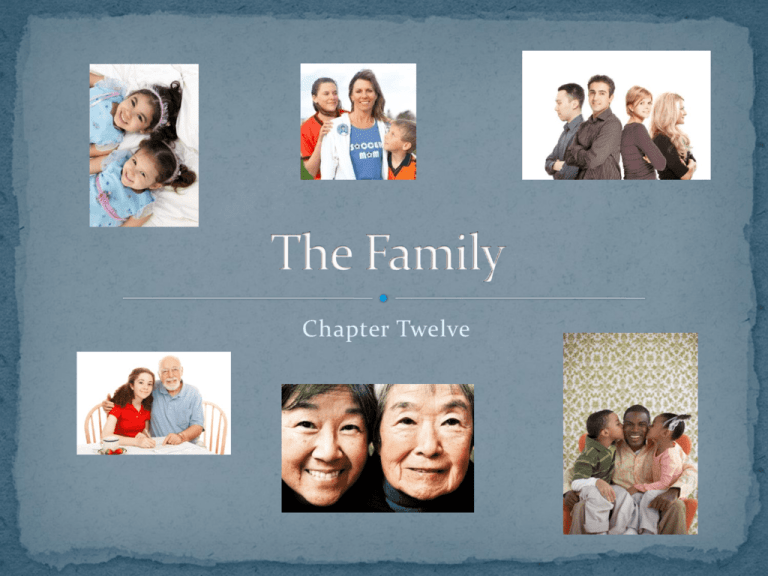
Chapter Twelve Section One A. The family is the most universal social institution B. Definition varies from culture to culture A. Definitions 1. Family: a group of people who are related by marriage, blood, or adoption and who often live together and share economic resources 2. Nuclear Family: one or both parents and their children (typical in America) a) Family of Orientation: the nuclear family you are born into b) Family of Procreation: the nuclear family you create 3. Extended Family: multiple generations living under one roof (grandparents, parents, children, aunts and uncles, and cousins) B. Kinship 1. Definition: a network of people who are related by marriage, birth, or adoption 2. Primary Relatives a) b) Members of the families of orientation and procreation Mother, father, sister, brother, spouse, daughter, and son 3. Secondary Relatives a) b) 4. The primary relatives of a person’s primary relatives Grandparents, grandchildren, in-laws, aunts, uncles, nephews, and nieces Tertiary Relatives a) b) The primary relatives of a person’s secondary relatives Great grandparents, great grandchildren, great aunts, great uncles, and cousins List five of your own primary, secondary, and tertiary relatives. A. Family organization is determined by answering four questions 1. 2. 3. 4. How many marriage partners may a person have? Who will live with whom? How will family membership be determined? Who will make the decisions in the family? Monogamy is common to industrialized nations 2. Polygamy is often permitted in pre-industrial societies 1. Polygyny: a man with more than one wife b) Polyandry: a woman with more than one husband a) Primarily in parts of Asia Where a newly married couple will live Patrilocality: live with or near the husband’s family 2. Matrilocality: live with or near the wife’s family 3. Bilocality: live with or near the family of choice 4. Neolocality: live apart from both sets of parents 1. How kinship is traced Patrilineal descent: trace kinship through the father’s family; property is passed from father to son 2. Matrilineal descent: trace kinship through the mother’s family; property is passed from mother to daughter 3. Bilateral descent: trace kinship through both parents; property can be inherited from either side of the family 1. Who is in charge Patriarchy: the father holds the authority 2. Matriarchy: the mother holds the authority 3. Egalitarian: shared authority 1. A. Regulation of Sexual Activity 1. 2. Enforce incest taboo: forbids sex between certain relatives—parents, siblings, grandparents, aunts/uncles, nieces/nephews Patrilineal groups do not consider some on their mother’s side to be family B. Reproduction: who can have children, how many to have, how to raise them, etc. C. Socialization: teach children how to interact with society D. Economic and Emotional Security 1. 2. 3. The family is the basic economic unit Divide labor based on gender and age The basic and most intimate group in society; provides emotional support Section Two A. The majority of Americans marry at least once for romantic love B. Most marriages are homogamous: we marry people very similar to ourselves (opposite is heterogamy) A. Family Violence 1. 2. 3. The most devastating problem A problem for all groups In 1975, 1/3 of all interviewed had been affected by family violence; did decrease through the 1980s B. Divorce 1. 2. 3. 50% of marriages end in divorce Most common among teen marriages, lower educated persons, and African Americans Women are affected financially and psychologically; men are affected psychologically C. Empty Nest Syndrome: when the kids leave home D. Death of a Spouse A. Delayed Marriage 1. 2. 3. Median age for first marriages Men Women 1960 22 20 1990 26 23 2013 29 27 It’s again acceptable to be single Women are pursuing education and careers before marriage B. Delayed Childbearing 1. Time between marriage and childbirth 1960s 15 months 1970s 27 months Today varies **some people choose to never marry 2. Sandwich Generation: people are caring for aging parents and young children at the same time C. Childlessness 1. 2. Choose careers over family Wait too long and have infertility issues D. Dual-earner Marriages 1. 2. Number of married women employed outside the home 1940 < 10% 1948 22% 2000 37% Today 61% Women are working for personal and economic reasons One Parent Families E. 1. 2. Formed through separation, divorce, death of a spouse, birth to unwed mothers, or adoption by unmarried persons Represents a large number of the families in the United States today (55% of African Americans, 31% of Hispanics, and 21% of European Americans) Remarriage F. 1. 2. 3. 40% of those that divorce remarry; has dropped as couples choose to cohabitate instead Has led to an increase in step/blended families—close to 60% of all people have step-relatives 67% of 2nd marriages and 74% of 3rd marriages end in divorce
